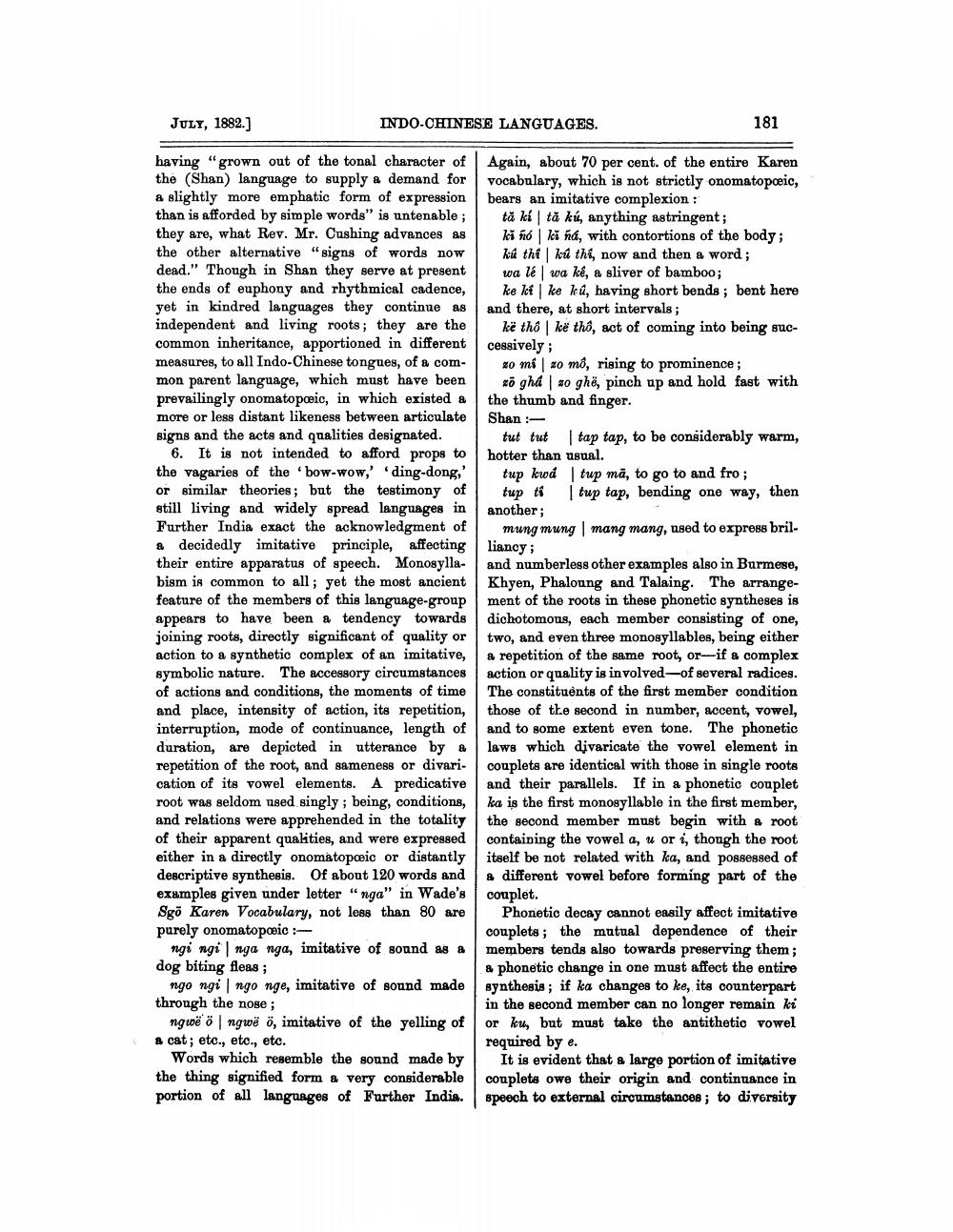________________
JULY, 1882.)
INDO-CHINESE LANGUAGES.
181
having "grown out of the tonal character of Again, about 70 per cent of the entire Karen the (Shan) language to supply a demand for vocabulary, which is not strictly onomatopoeic, a slightly more emphatic form of expression bears an imitative complexion : than is afforded by simple words" is untenable ; tă kită kú, anything astringent; they are, what Rev. Mr. Cushing advances as ki fióki na, with contortions of the body; the other alternative "signs of words now ká thi kú thi, now and then a word; dead." Though in Shan they serve at present wa lé wa ké, a sliver of bamboo; the ends of euphony and rhythmical cadence, ke kike kú, having short bends ; bent here yet in kindred languages they continue as and there, at short intervals; independent and living roots; they are the kë tho ke tho, act of coming into being succommon inheritance, apportioned in different cessively; measures, to all Indo-Chinese tongues, of a com- 20 mio mo, rising to prominence; mon parent language, which must have been
gha | no ghë, pinch up and hold fast with prevailingly onomatopoeic, in which existed a | the thumb and finger. more or less distant likeness between articulate Shan :signs and the acts and qualities designated. T tut tut tap tap, to be considerably warm,
6. It is not intended to afford props to hotter than usual. the vagaries of the bow-wow,' 'ding-dong,' | tup kud | tup ma, to go to and fro; or similar theories; but the testimony of tup ti tup tap, bending one way, then still living and widely spread languages in Further India exact the acknowledgment of mung mung mang mang, used to express brila decidedly imitative principle, affecting liancy; their entire apparatus of speech. Monosylla- and numberless other examples also in Burmese, bism is common to all; yet the most ancient Khyen, Phaloung and Talaing. The arrangefeature of the members of this language-group ment of the roots in these phonetic syntheses is appears to have been a tendency towards dichotomous, each member consisting of one, joining roots, directly significant of quality or two, and even three monosyllables, being either action to a synthetic complex of an imitative, a repetition of the same root, or--if a complex symbolic nature. The accessory circumstances action or quality is involved-of several radices. of actions and conditions, the moments of time The constituents of the first member condition and place, intensity of action, its repetition, those of the second in number, accent, vowel, interruption, mode of continuance, length of and to some extent even tone. The phonetic duration, are depicted in utterance by laws which divaricate the vowel element in repetition of the root, and sameness or divari. couplets are identical with those in single roots cation of its vowel elements. A predicative and their parallels. If in a phonetic couplet root was seldom used singly; being, conditions, ka is the first monosyllable in the first member, and relations were apprehended in the totality the second member must begin with a root of their apparent qualities, and were expressed containing the vowel a, u or i, though the root either in a directly onomatopoeic or distantly itself be not related with ka, and possessed of descriptive synthesis. Of about 120 words and a different vowel before forming part of the examples given under letter "nga" in Wade's couplet. Sgo Karen Vocabulary, not less than 80 are Phonetic decay cannot easily affect imitative purely onomatopoeic :
couplets; the mutual dependence of their ngi ngi nga nga, imitative of sound as a members tends also towards preserving them; dog biting fleas;
a phonetic change in one must affect the entire ngo ngingo nge, imitative of sound made synthesis ; if ka changes to ke, its counterpart through the nose;
in the second member can no longer remain ki ngwë ö ngwë ö, imitative of the yelling of orku, but must take the antithetic vowel & cat; etc., etc., etc.
required by e. Words which resemble the sound made by It is evident that a large portion of imitative the thing signified form a very considerable couplets owe their origin and continuance in portion of all languages of Further India. speech to external circumstances; to diversity




